
































































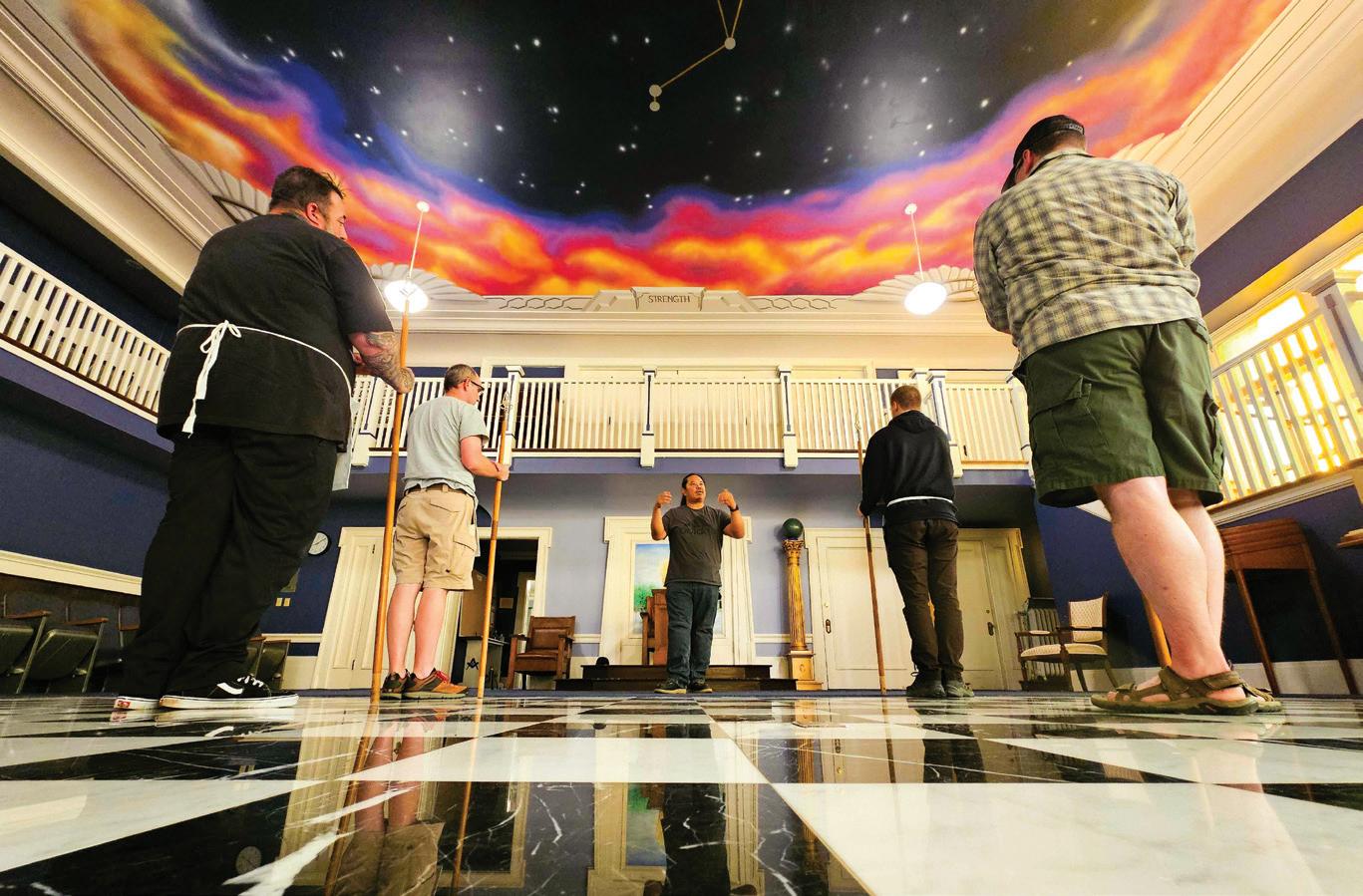
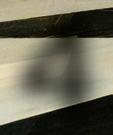














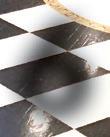

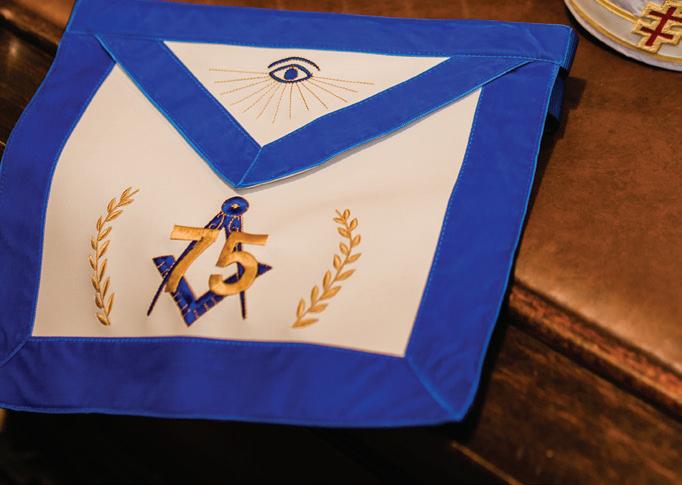



November is upon us, and it’s a time to give thanks. In our Trestle Board, the rule and guide of our life, we fi nd in 1 Thessalonians 5:18, “In everything give thanks: for this is the will of God in Christ Jesus concerning you.” But what does this truly mean? It encourages us to be grateful in all circumstances, no matter the situation. Even in difficult or challenging times, gratitude aligns with God’s will for those who follow Christ. It fosters a mindset of trust and faith, reminding us that God has a purpose in every situation. By maintaining gratitude, we help ourselves remain positive and faithful.
We have much to be thankful for in Oregon Freemasonry. The number of men knocking on our doors, inquiring about our fraternity as we emerge from the pandemic, is remarkable. Across the state, we see inspiring Degree work, and Brothers stepping up to assist neighboring Lodges in raising Master Masons is particularly encouraging. Th is month, as you vote for those who will lead your Lodge in 2025, take a moment to appreciate the good Brothers willing to put in the work and help your Lodge advance to the next level of success.


As your Grand Master, I am encouraged daily by the support and efforts I witness during my Official Visits around the State of Oregon. Both your Grand Lady Teresa and I wish you a very Happy Thanksgiving, and we hope you will have the opportunity to spend it surrounded by family and friends. Live Masonry Every Day!
Sincerely and Fraternally,
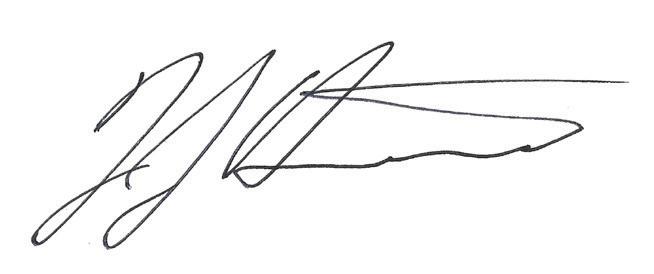
Timothy J. Best Grand Master 2024-2025









M.W.B. Michael J. McGuyer, P.G.M.
Thank you, M.W.B. Timothy Best, for the opportunity to reflect on my time as Grand Master during the challenging year of 2020. Like many, I initially believed the COVID situation would resolve in six months, and we’d soon return to normal. I was certainly mistaken. That year forced me to make difficult decisions, some of which I didn’t agree with personally, but were necessary for the greater good.
Doing the right thing is rarely easy. From the outset, it became clear that circumstances were rapidly shifting and becoming increasingly restrictive. Meeting capacities and guidelines were in constant flux. Whatever measures were required to protect our members, safeguard the Fraternity, and comply with government mandates had to be implemented. After many discussions with the Trustees, I made the difficult decision to place a moratorium on Degree work—a decision no Grand Master had ever intentionally made before.
Adapting to the ever-changing government guidelines for gatherings was like trying to nail Jello to a wall. It would have been simpler to close the Jurisdiction altogether, as others had done, but that wasn’t a solution we were willing to accept. The Trustees and I were committed to keeping Lodges active, knowing that prolonged inactivity could lead many to fail permanently. I was fortunate to have the invaluable support of Grand Secretary R.W.B. Rick Komraus, who provided daily updates on occupancy restrictions set by the Oregon Health Authority.
With edicts in place and attendance limits enforced, it
became clear that Official Visits were no longer feasible. Rather than attempting to work around my own restrictions, I chose to lead by example and cancelled my calendar.
Th roughout that difficult year, I had no shortage of critics. A glance at my email inbox would confi rm that. But I was equally blessed with unwavering supporters. The Grand Secretary and his dedicated staff, the Jurisprudence Committee led by M.W.B. Anderson, who helped guide me through these uncharted waters, and the Trustees of the Grand Lodge, the fi nest group of men I could have hoped to work alongside. I also extend my deepest respect to the Worshipful Masters who led their Lodges with steadfast dedication during 2020 and 2021.
I believe it’s important to carry forward a few lessons: Take nothing for granted and be thankful—especially for the people who are part of your life. COVID’s harshest lesson was how easily those we care about can be taken from us. Never take your brethren for granted, and always treat them as if they’re leaving on a long journey.
Leadership carries the burden of second-guessing decisions. But I stand by the choices we made, grounded in our fidelity to Freemasonry. Looking back, I believe we did the right thing. Above all, I offer my deepest thanks to the one who deserves the most credit: the Great Architect of the Universe. As our Lodges return to full activity, may we embrace this opportunity to strengthen our bonds, rejuvenate our commitments, and carry the light of Freemasonry forward with renewed purpose and optimism.
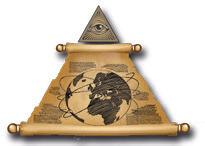















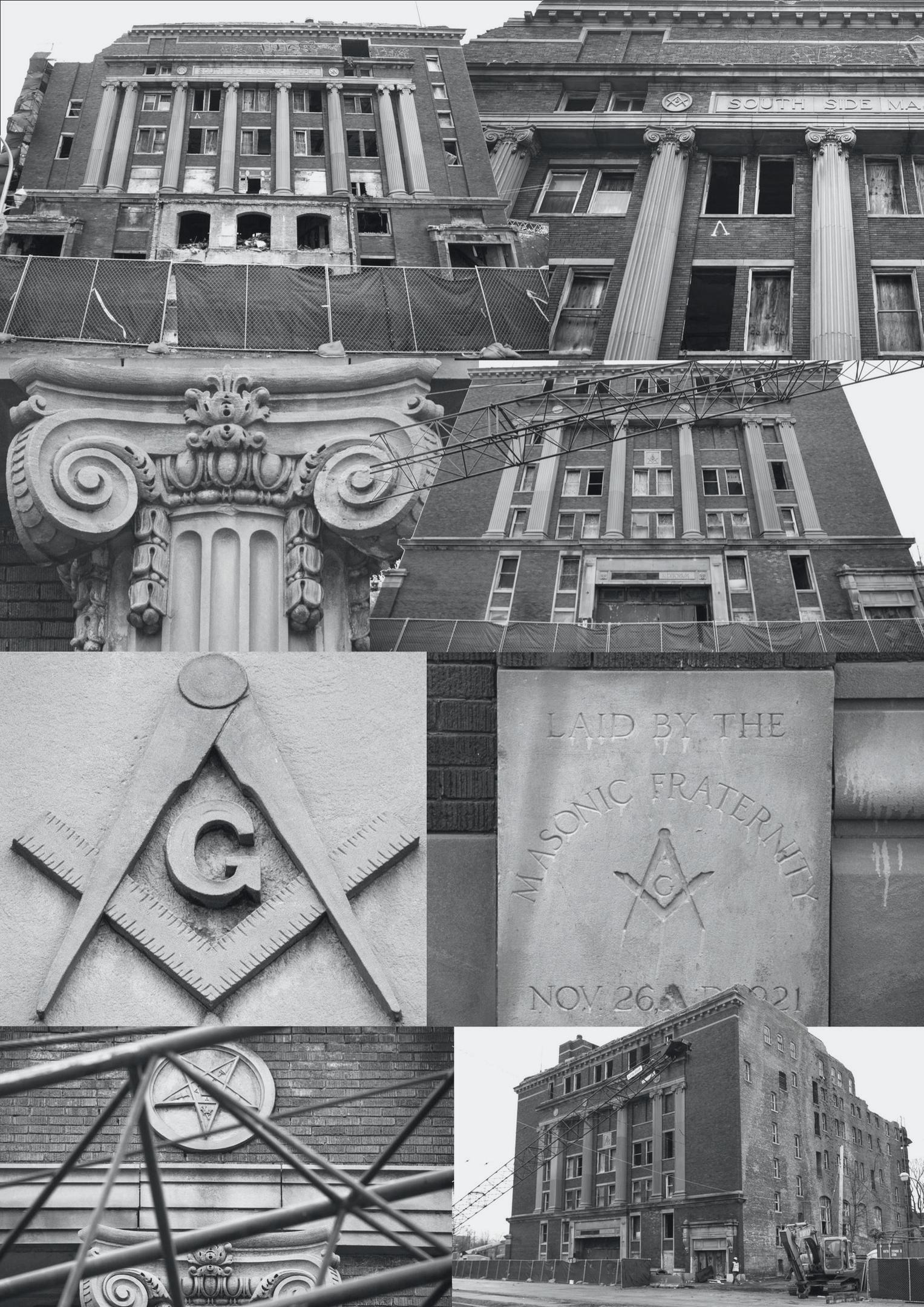

W.B. Dale B. Palileo, Grand Lecturer
While our Ritual is based on a progressive science, there is also a significant element of art in how it is manifested. This is especially apparent when one considers the care that Brothers take in giving a lecture, a charge, reciting a few lines, or more notably, in performing Ritual floorwork together.
Ritual floorwork, when properly done—accounting for timing, movement, and an element of theatrics—is a sight to behold. Proper execution of the Degree floorwork has a profound impact not only on the participating Brothers but, most importantly, on the candidate, for whom the Lodge bears the solemn responsibility of delivering an exceptional initiatic experience. It leaves a lasting impression of an important night and reminds Brothers of the Degree’s lessons and their obligations.
In other words, floorwork is Masonic Ritual brought to life. But how can we properly perform proper Ritual floorwork with the quality deserving of the candidate, our brethren and ourselves? Here are a few guidelines to help you and your Lodge:
For the most part, everything that we need to know about how to perform proper Masonic floorwork in Oregon is in “The Ritual,” the book from which much of our Masonic work is written whether in cipher or plain text form. Unfortunately, it is easy to overlook the bold and underlined sections of the Ritual because we are trained to spot the ciphered portions.
I encourage you to read these sections as you study your Degree parts. You may be surprised by how much valuable information lies within the bold and underlined sections, offering key insights to help you perform your role more effectively. It will also give you a solid foundation in assuming other roles in the Degree.
And although our Ritual book provides detailed guidance on floorwork, it is flexible enough to accommodate the creation and maintenance of Lodge customs. Consult your Lodge’s ritual or officers’ coach to become familiar with your Lodge’s conferral customs and traditions, as these reflect the essential elements your Lodge values in the candidate’s Degree experience.
Aside from knowing your lines, practicing your role’s floorwork is the second most important element in your part of the Degree conferral. This becomes more apparent when you consider the space where you will be working, and even more so if you consider the movement of other officers. A 20-minute run-through of your role’s floorwork can do wonders in your overall performance during the Degree. However, with continued practice, you’ll discover more efficient and graceful ways of performing each part, enhancing the quality of the Degree experience. Over time, your movements will become second nature, allowing you to perform with greater polish and confidence.
In every Degree conferral, every role holds equal importance, from the Tyler at the door to the Worshipful Master in the Oriental Chair. While some roles may carry greater responsibility with more lines or intricate floorwork, the absence of any one part can prevent the Degree from being properly conferred. But even when all are present, proper coordination of all moving parts is essential. Like a fine-tuned clock, every movement and spoken word needs to

be properly coordinated with one another so that the correct tone, feeling and collective experience is achieved. A perfect example of this is during the circumambulation, where the movement of the Senior Deacon, the raps of the stations, and the Chaplain’s lines must all be perfectly timed in order to achieve the desired effect on the candidate.
Again, practice is an essential element in building seamless teamwork, ensuring that every member moves in harmony and fulfills their role with precision. Set aside an evening a week before the Degree date to practice with as many cast members as possible to fine-tune everyone’s floorwork and set expectations.
Mastering Masonic Ritual floorwork requires more than just memorization and repetition—it demands a deliberate intent and focused mindset.
Intent guides our actions with purpose, ensuring that every movement, gesture, and word reflects the gravity of the Ritual. Mindset, on the other hand, cultivates the mental discipline needed to perform with confidence and composure, allowing us to be fully present in the moment.
Why are these important? Together, intent and mindset transform the floorwork from mere choreography into a meaningful experience, elevating both the candidate’s journey and the collective spirit of the Lodge.
Put simply: If we want to inspire an engaged and active Brother, we must provide him with an exceptional Degree experience. Achieving this requires more than just following the Ritual—it demands that every participant remembers the deeper purpose behind the Degree.
Being fully ‘in the moment,’ with clear intent and focused mindset, ensures that our actions reflect the significance of the Ritual and leave a lasting impact on the candidate.
As a final thought, I’m reminded of the timeless aphorism, “If it’s worth doing, it’s worth doing right.” This principle serves as a compass for us in refining our Lodge’s Ritual and floorwork, reminding us that excellence is not an end but a journey—one worth pursuing with intention and dedication.
When every Brother fulfills his role with care and precision, the Degree becomes more than a ritual; it transforms into an experience that embodies the harmony we so often hear the Senior Warden reference during the Lodge’s opening and closing. This harmony reflects the very essence of Freemasonry—a path of personal growth and selfimprovement undertaken not for ourselves alone but for the benefit of the communities we serve.
In perfecting our Ritual, we not only strengthen our bonds as Brothers but also reaffirm our commitment to becoming better men.

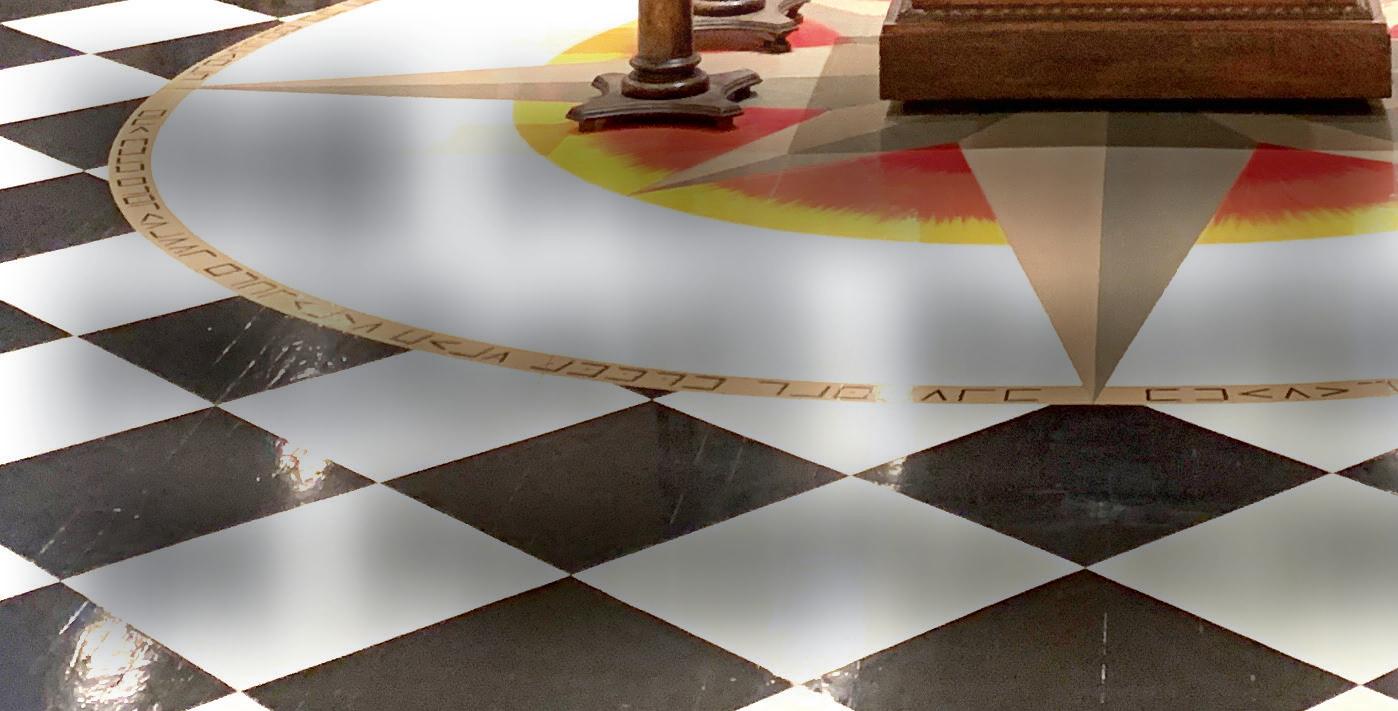

When given tours in many Masonic Lodges around the world, some people will notice the Mosaic Pavement (or Masonic checkered floor tile) and wonder what it means.
In many such Lodges, it will be found in the very center of the floor of the Lodge room.
In his Encyclopædia of Freemasonry, Dr. Albert Mackey provides us with the following historical explanation in his entry “Mosaic Pavement”:
“Mosaic work consists properly of many little stones of diff erent colors united together in patterns to imitate a painting. It was much practiced among the Romans, who called it musivum, whence the Italians get their musaico, the French their mosaique, and we our mosaic. The idea that the work is derived
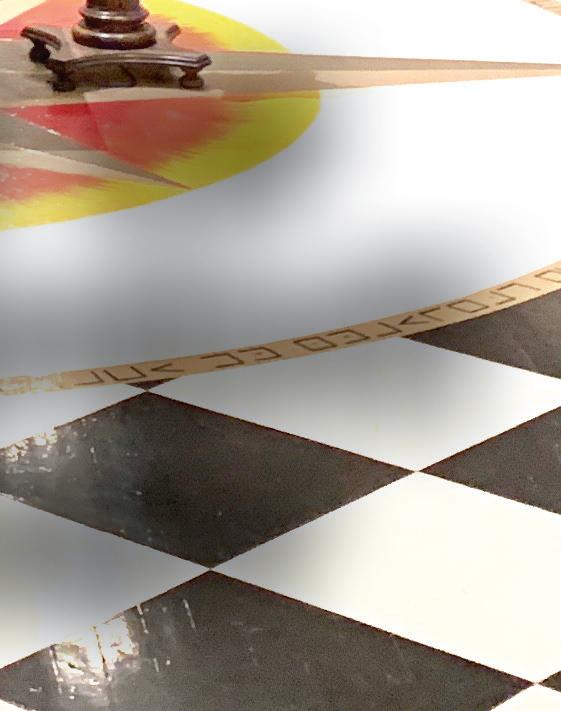
written by Brandon Cole for Masonic Find photo of Bend Lodge No. 139 by M.W.B. Mark L. Posler, P.G.M.

from the fact that Moses used a pavement of colored stones in the tabernacle has been long since [explored] by etymologists. The Masonic tradition is that the fl oor of the Temple of Solomon was decorated with a mosaic pavement of black and white stones. There is no historical evidence to substantiate this statement.
Samuel Lee, however, in his diagram of the Temple, represents not only the fl oors of the building, but of all the outer courts, as covered with such a pavement. The Masonic idea was perhaps first suggested by this passage in the Gospel of St. John (xix. 13), ‘when Pilate, therefore, heard that saying, he brought Jesus forth, and sat down in the judgment-seat in a place that is called the Pavement, but in the Hebrew, Gabbatha.’ The word here translated Pavement is in the original Lithostroton, the very word used by Pliny to denote a mosaic pavement. The Greek word, as well as its Latin equivalent, is used to denote a pavement formed of
ornamental stones of various colors, precisely what is meant by a mosaic pavement.
“There was, therefore, a part of the Temple which was decorated with a mosaic pavement. The Talmud informs us that there was such a pavement in the conclave where the Grand Sanhedrim held its sessions.
“By a little torsion of historical accuracy, the Masons have asserted that the ground floor of the Temple was a mosaic pavement, and hence, as the Lodge is a representation of the Temple, that the floor of the Lodge should also be of the same pattern. …”
The Mosaic Pavement can be found in most (if not all) regular lodges throughout the United States and Canada; it is probable, because of the variation of ritual (and therefore of Lodge requirements) that a few exceptions exist in the US and Canada and that the requirement is not as widespread in other countries (particularly in Europe).
However, this does not in any way, shape, or form take away from the universality of the principle that this symbol represents in Freemasonry.
Just as with any other symbol, I come across this one fairly often in my daily life, especially outside of Masonic environments. Having grown up in Indiana, I saw the checkered flag and finish line quite often at NASCAR events.
In addition to seeing it regularly at my local lodge, I occasionally see the pattern on the ball cap, shirt, or shoes of a passerby, as well as on the tiled floors of some other buildings.
Each time, I am reminded of the following things:
• I am imperfect.
• It is okay that I am imperfect.
• I should strive to be morally straight.
In short, the Mosaic Pavement represents the moral fallibility of mankind.
In completion of the abovereferenced entry, Mackey explains the purpose behind the symbol, what type of symbol it is, and what other symbols accompany it:
“The mosaic pavement is an old symbol of the Order. It is met with in the earliest rituals of the last century. It is classed among the ornaments of the Lodge in combination with the indented tessel and the blazing star. Its party-colored stones of black and white have been readily and appropriately interpreted as symbols of the evil and good of human life.”
Given that Freemasonry is a system of morals, it is fitting, therefore, that it should have a symbol that illustrates the fallible, imperfect nature of mankind, which nature results in us all being subject to committing moral error.
We all make bad decisions and exercise poor judgment at some point in our lives. When we focus on living a morally straight life, the likelihood of making such decisions decreases.
• When I find that I have fallen short in this regard, I should:
• Make restitution to the best of my ability.
• Move on and try not to repeat this error.
• I should replace bad habits with good ones.
The Mosaic Pavement may not have been a literal, historical part of King Solomon’s Temple; it may only be a relatively recent Masonic tradition.
After all, the account of the construction of King Solomon’s Temple is only used in Masonry as the setting for its moral allegory (much of which allegory seems also to have been invented).
This all stated and as is the case with many other symbols, I am grateful to have this consistent reminder in my life.
The endeavor to become a better person necessitates the knowledge we are all, in one way or another, subject to committing moral error—but capable of refining our respective moral characters by the application of various working tools (or moral principles).
The value of Masonry’s interpretation of this symbol and use as its ornament, however, is very real.
Each of us has the responsibility to advance the moral standards of our species by endeavoring to practice every commendable virtue; such is especially our engagement as Masons.
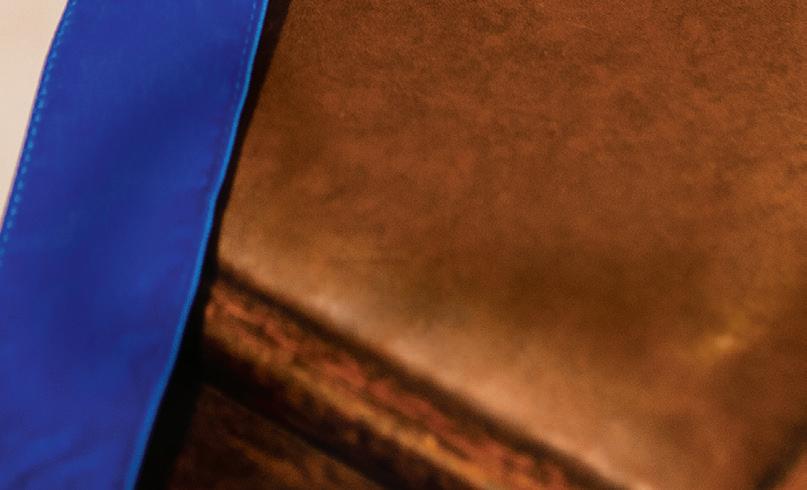


We wish to extend our deepest appreciation and congratulations to these long-standing Brothers.
This list includes Brothers who have achieved a membership milestone in the 2024 calendar year as of the printing of this issue.




Richard H. Shettler 157
Jack E. Stevens 139
Rodney E. Thompson 51
William H. Toliver 84
Silas R. Vermilyea 158
James R. Wallace 160
Kenneth D. Watson 11
Fred M.Arnst 41
Larry R. Beck 27
Robert L. Bergner 46
Lowell P. Cook 175
James W. Damon 34
John V. Doty 2
Larry A. Dugan 112
Earl W. Force 1
William A. Foster 27
L. Bert Girod 207
Joe H. Griggs 51
Ronald K. Hamer 11
Richard L. Harper 17
Allen R. Herndobler 96
James L. Holmes 46
Burton L. Huggett 6
Raymond L. Isaacs 109 John James 16
Kenneth A. Marlow 1
John W. McAllister 97
David J. McGhee 7
Floyd R. McHargue 103
Robert A. McKinney 11
James C. McNamara 154
Gregory L. Nelson 140
Michael Ohair 77
John D. Ritchie 15
Richard C. Ronk 215
William R. Shrader 103
William R. McCarthy 14
Burton H. Douglass 139
Steven G. Borbely 155
Nelson D. Atkin, II 100
Gerry E. Backanen 7
William E. Best 103
Kenneth I. Blagg 15
Roger B. Blamire 45
Delbert F. Boyd 157
Lyle L. Brown 138
Merle R. Brown 14
William O. Brown 15
Kenneth C. Burdick 88
Peter J. Constantine 100
Todd D. Cooper 4
W. Greg Davidson 207
Rolland D. Davis 13
Millen E. DeForest 4
Wayne L. Dennis 156
Bradley C. Doane 195
Joseph D. Egeline 10
William M. Elliott 156
G. Wayne Enlow 16
Thomas L. Evans 30
Roy O. Gaylord 105
Richard T. Greene 104
David A. Grindle 118
C. William Groulx 133
Richard C. Hadlock 133
Steven C. Hale 52
Lenard J. Hansen 7
James W. Harais 85 Alan L. Harrison 44
James J. Hogue 226
Terry R. Hooks 18
Daniel P. Hornych 1
Paul L. House, Jr. 118
Jack L. Howard 96
W. Rocky Johnson 221
Kenna C. Jordan 13
William E. Kendrick 1
Ronald L. Kerlee 11
David P. Kline 85
Terry M. Kuhn 140
James J. Kunkel 158
Lawrence J. “Larry” Lane 13
Paul E. Larson 17
Christian S. Lassen 160
Steven L. Lindley 105
Robert O. Long 76
Thomas E. Luttrell 207
Fred Lutz 11
John A. McKendrick 112
Robert L. McManus 11
Billy J. McMinn 89
Gary W. Mehaffey 11
Larry A. Nelson 140
William O’Hara 85
Robert E. Owen 46
Charles A. Rhoads 67
Richard D. Riley 155
Donald L. Rivers 158
Milton S. “Sid” Roberts 24
Vernon W. Rush 7
Gerald E. Saunders 195
William C. Schaubel 104
Ivan G.Schrader 16
Gene A. Schrieber 77
James P. Shaw, Jr. 223
David R. Smith 223
Richard K. Smith 77
Eugene N. Spencer 15
Russell D. Springer 77
Donald F. Stapleton 46
Francis V. Story 77
Frank V. Surroz, Jr. 77
Robert G. Thomas 78
Richard F. “Dick” Tooley 107
Sam M. Wade 81
David V. Ward 77
Glen Weeks 221
Brian L. Whitham 16
Dennis Woitte 29
If you have not received your 50-year jewel, contact your Home Lodge Secretary.
No. 46
No. 30
No. 41
Lodge No. 9

No. 206
Reames Chapter No. 66
Adah Chapter No. 34
Widow, Jennings Lodge No. 9
Silver Wave Chapter No. 18
Widow, Lents Lodge No. 156

























The holiday season is here once again, and our annual MasonicAid Giving Tree program is underway. MasonicAid has carefully selected 40 Masonic & Eastern Star members who may be in poor health, in need of fi nancial assistance, or grieving the loss of a loved one, to receive a gift from the membership at Christmastime. If you would like to make a fi nancial donation to one of our MasonicAid Sisters and Brothers, please select a member from the list.
Thank you for helping us continue the tradition of charity and goodwill and supporting our most vulnerable MasonicAid members during the holiday season!

11. Friendship Rose Chapter No. 148
12. Cott age Grove Chapter No. 4
13. La Grande Lodge No. 41
14. East Gate Lodge No. 155
15. Ashland Lodge No. 23
16. Enlightenment Lodge No. 228
17. Friendship Rose Chapter No. 148
18. Union Lodge No. 3
19. Klamath Lodge No. 77
20. North Bend Lodge No. 140
21. Corvallis Lodge No. 14
22. Rainier Lodge No. 24
23. McKenzie River Lodge No. 195
24. Adah Chapter No. 34
25. Wabanang Chapter No. 127
Donate online at www.OregonFreemasonry.com/Donate or call the Grand Lodge office at 503.357.3158. Give by Friday, December 13 to allow delivery by Christmas.
26. Widow, Kenton Lodge No. 145
27. Widow, Cornerstone Lodge No. 157
28. Willamette Lodge No. 2
29. Jefferson Lodge No. 33
30. Grants Pass Lodge No. 84
31. East Gate Lodge No. 155
32. Pioneer Lodge No. 28
33. Esther Chapter No. 11
34. Holbrook Lodge No. 30
35. Tualatin Chapter No. 31
36. Washington Lodge No. 46
37. Columbia Lodge No. 114
38. Valliant Sellwood Chapter No. 92
39. Widow, Tigard-Orenomah Lodge No. 174
40. Valliant Sellwood Chapter No. 92
- MasonicAid Giving Tree recipient “ “
Thank you from the bottom of my heart for the wonderful and generous donation. I cannot describe how it makes me feel to receive this. God Bless and Merry Christmas!





Could your spouse or family use immediate financial assistance in the event of your passing?

The Masonic Low Twelve Club is not an insurance policy. Low Twelve membership assures that a check is delivered to the member’s intended recipient immediately upon report that the member has passed away. No proof of loss, claim forms, or death certificate is required. Oral or written notification to the Secretary or any current Board of Directors is sufficient to get the Low Twelve wheels in motion. Th is program is designed to relieve the Brother’s family of one significant source of stress during their hour of grief: immediate access to cash.
A designated recipient may be any person or organization of your choice. Typically, widows are chosen as the recipient, however, other family members or an organization can be chosen. And you can split it up however you wish. Currently, the benefit is $600 and is usually mailed out within 24 hours of notification. Membership conveniently implements the Masonic obligation of assistance to widows and orphans.
The Low Twelve Club, Inc. is a registered non-profit corporation that operates with By-Laws and a Board of Directors. An annual meeting is held in July in conjunction with a social event, usually a dinner at a local Lodge in Salem. Attendance is open to current and prospective members, family, and friends.
Annual dues are $50 and due in January. If you wish, you can split that up into two payments of $25 each, due in January and June. Members will be mailed notifications at the time of the assessment cycle.
Applications are available by calling or emailing one of the officers below.
W.B. Anthony Chase, President 971.218.2994
mastermasonschase@gmail.com
W.B. James Van Anda, Secretary/Treasurer 971.304.9365
jvananda63@gmail.com
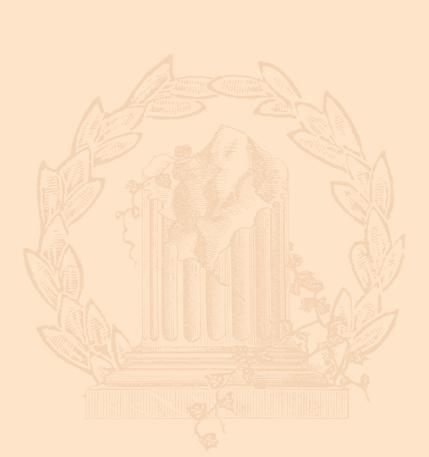

The Light That Binds made a shirt with the Grand Master’s theme for the year—EVERYDAY. To read more about it and help purchase a shirt follow the link below.
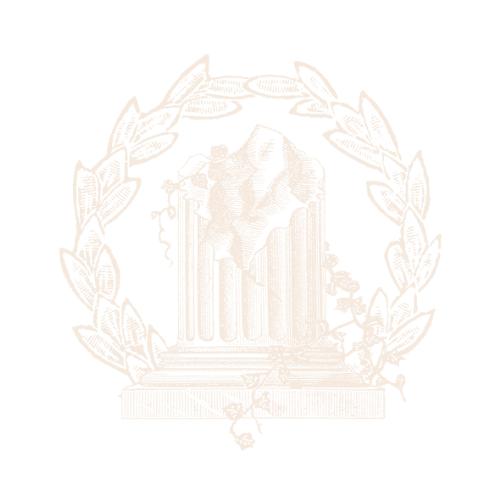
One hundred percent of the profits go to Oregon Masonic Charities. TheLightThatBinds.com/products/ EVERYDAY
SCAN THIS QR CODE TO ORDER YOUR “EVERYDAY” SHIRT
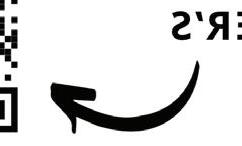
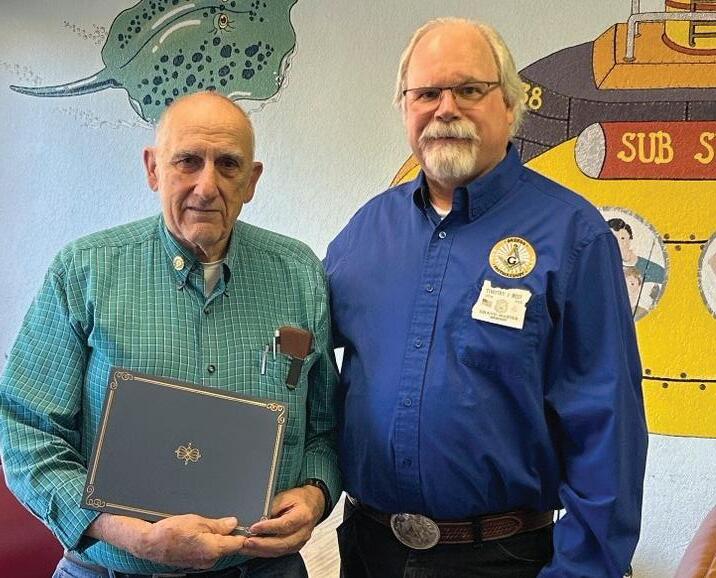
M.W.B. Timothy J. Best presented a 60-year certificate and pin to Bro. Vernon R. Rodighiero on behalf of the Grand Lodge of Florida.
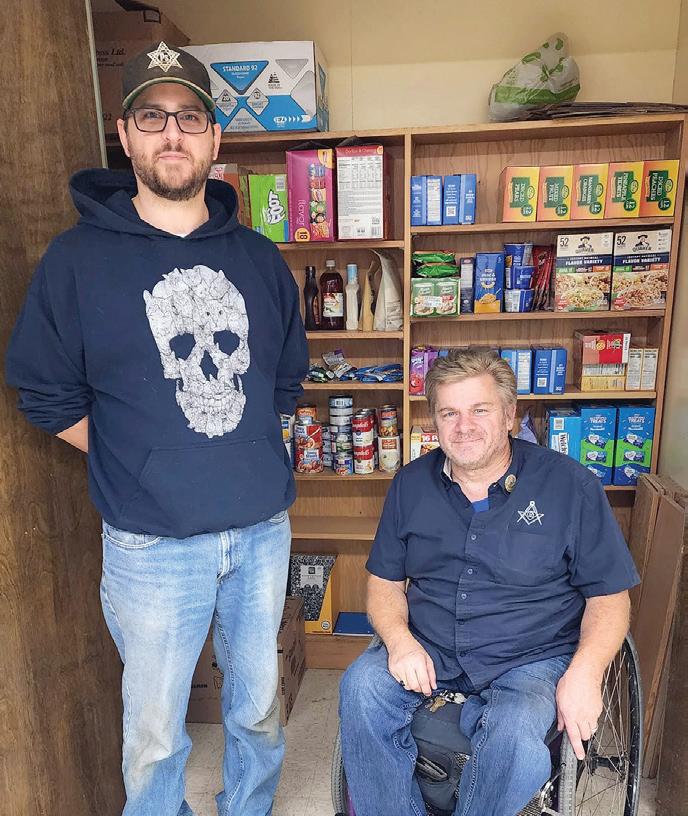
Bro. Ross A. Ayers and W.B. Anthony S. Chase of Salem Lodge No. 4, delivered food to Brush College Elementary School where pantry shelves were empty.
The Lodge plans to provide Christmas turkey/ham holiday boxes. A special thanks to Trinity Chapter No. 175 OES for their generous assistance and donations.
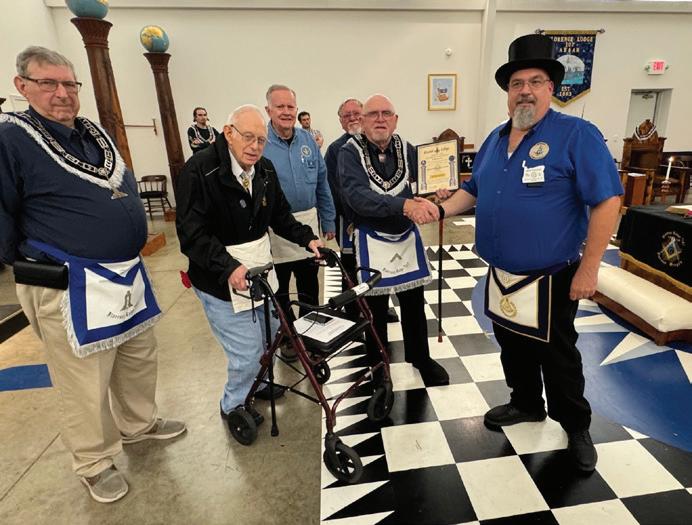
No. 107
Left to right: M.W.B. Thomas M. Velvin, Jr., P.G.M. of Maryland, Bro. Dean S. Hirst, (50-year member)
W.B. Fritz H. Thomas, III, (50-year member), W.B. David L. Chester, (50year member), W.B. Richard F. “Dick” Tooley, R.W.B. Michael D. Sullivan.

Sherwood-Midday Lodge No. 164 participated in the city of Sherwood Robin Hood Day parade.
From left to right: W.M. Joseph M. Miluso, W.B. Martin L. Bradford, W.B. Michael J. Thompson, W.B. Wayne K. Ford, W.B. William “Billy” T. Burns, D.D. 6.
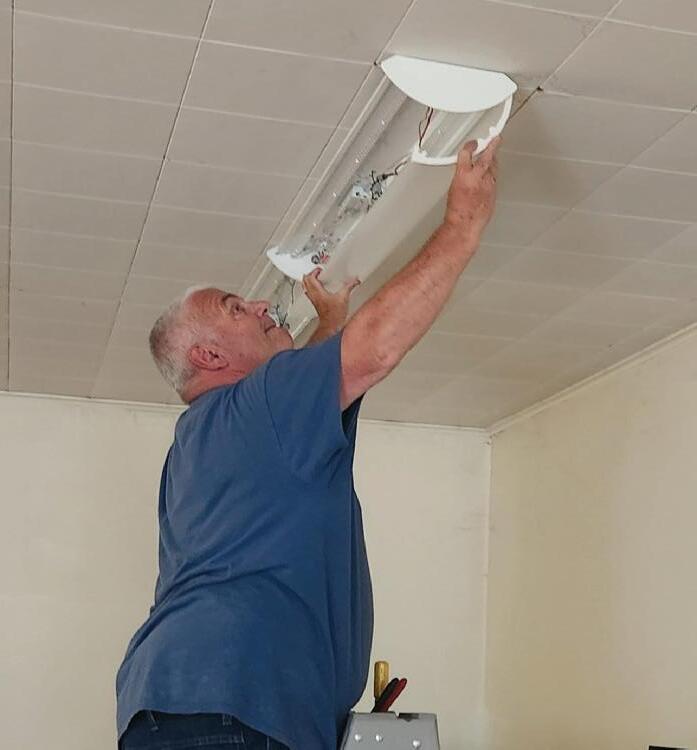
South Umpqua Lodge No. 72 recently performed lighting upgrades on their entire Lodge in Canyonville. They had several Brothers who came and helped out on four separate occasions, with a breakfast provided by the Lodge.
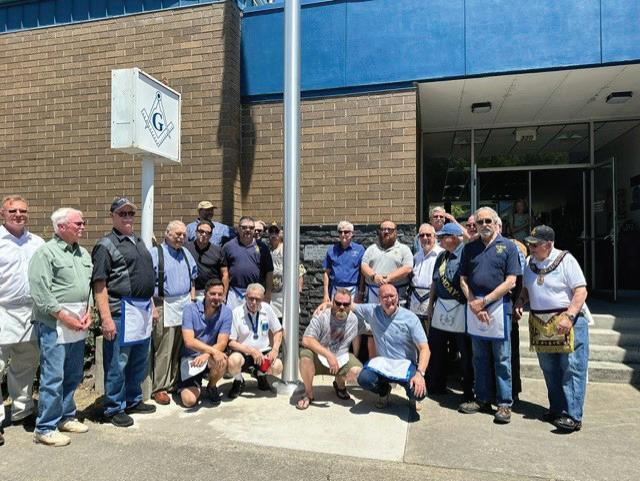

On Saturday, June 22, a four-year effort culminated with the dedication of a new flagpole at Grants Pass Lodge No. 84, in memory of W.B. Robert Hamilton. Bob, a Past Master of both Grants Pass No. 84 and Rogue River No. 226, and a dedicated Shriner, was known for his deep involvement in Masonry and his connection with fellow brethren. Many affectionately called him “Dad,” and his legacy continues to inspire members today.
The ceremony was well-attended, including four Grants Pass Police officers and VFW Post No. 2032’s color guard, who presented the flag. W.B. Greg Gilbert and M.W.B. Richard Sorroz gave heartfelt remarks, highlighting Bob’s impact and the lasting friendship they shared. Bob’s daughter, Elaine Booth, and her husband W.B. Steve Booth, were also present. Steve played a key role in installing the flagpole, using his construction expertise.
This flagpole serves as a lasting tribute to W.B. Bob, whose memory and influence will continue to shape our Lodge for years to come.
e Grand Lodge of A.F. & A.M. of Oregon
2150 Masonic Way
Forest Grove, OR 97116
Change service requested

Scan this QR Code for a quick link to the other issues of the OMN.

